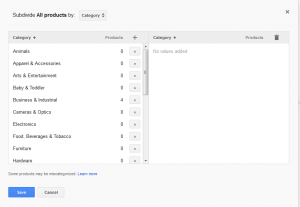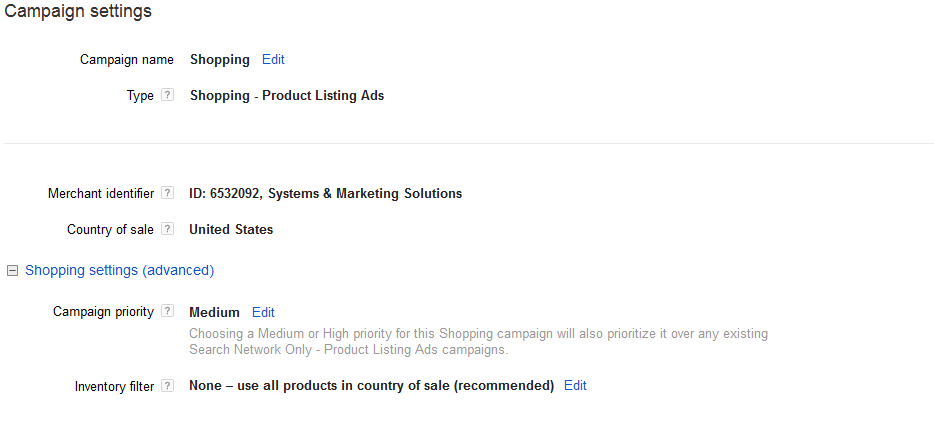The one constant in Google is change and that is as true as ever today. This applies to all aspects of AdWords advertising, and Product Listing Ads (PLAs) are no exception.
Recently, Google introduced Google Shopping as the next generation of Product Listing Ads. While Google Shopping is very similar to PLAs in many respects, there are some changes to the interface and reporting that PLA & Google Shopping Advertisers need to be aware of.
RETAIL CENTRIC:
Retail Centric is a major buzzword that Google is throwing around when discussing Google Shopping campaigns. In plain English, this refers to the ability of being able to browse product inventory directly in the AdWords interface instead of having to go into the Merchant Center.
One new and useful aspect that falls under Google’s infatuation with the term Retail Centric is that Google Shopping makes it easier to break up the products in your product feed by Category (i.e. Business, Electronics), Brand (Specific Brand Name), Item ID (Specific Product Level), Condition (New, Refurbished, Used), Product Type and five Custom Labels.
Assuming, you have an active Google Merchant Center account (which is required to run both PLA & Shopping Campaigns), the system will create an All products category by default. From there, you will click the second icon (that looks like a pen) to start browsing your inventory.
Once you select the elements of your product feed that you have broken things down by, you are able to set separate bids based off of each breakdown, giving you the ability to bid more or less based on the value you get for each separate Product, Category, Type, etc.
ADVANCED REPORTING:
One other weakness with PLAs that has started to be addressed with Google Shopping are the metrics used to report account performance.
The performance reporting metrics in PLAs are a bit archaic. The reporting metrics while still leaving a lot to be desired in Google Shopping, are a step in the right direction. In the Product Groups tab in Google Shopping, you can see performance statistics broken down by however you decided to break things down and you can even see Impression Share (percentage of time your ads show up when they are eligible to do so).
While Impression Share data has been readily available for Search & Display Network campaigns for a long time, this data has not been available for PLA campaigns.
COMPETITIVE LANDSCAPE DATA:
They have even introduced a couple new Shopping specific metrics (Benchmark CTR & Benchmark Max CPC). Benchmark CTR is described as:
“…how other advertisers’ Product Listing Ads for similar products are performing based on how often people who see their ad end up clicking on it.”
Benchmark Max CPC is described as:
“The benchmark maximum cost-per-click (max. CPC) tells you how other advertisers are bidding on similar product.”
While these two new metrics may sound highly useful on the surface, the one thing you need to be careful with regarding these metrics is that while there is an element of truth in the numbers produced by these metrics, there is also an element of Google trying to get you to spend more money as well.
Currently, Google is still allowing advertisers to run both PLA & Google Shopping campaigns at the same time. Based on Google’s MO, our estimate is that at some point they will require advertisers to run Google Shopping instead of PLA ads.
Since this has not happened yet, our recommendation is to move products over from PLA to Google Shopping incrementally (a few product lines at a time). Google is saying that the matching criteria are the same between these two areas and there shouldn’t be a difference in performance but then again it’s not the best idea to blindly follow these types of recommendations.
For advertisers still transitioning from PLA to Google Shopping, you have the ability to choose Campaign Priority (High, Medium, Low) to tell the system whether the specific Shopping Campaign should be given higher priority in comparison to PLA campaigns that are still active.
To adjust this, you can go to the Settings tab, click on the Shopping settings (advanced) icon and select your preferred campaign priority.
While there are many similarities between PLA ads and Google Shopping, one thing that encourages us is that there is a little bit more transparency & ease in evaluating performance at the product level (even though we all know that the information is partial as always). Just like any other Google feature or update that gets introduced, the key thing is to stay alert and make sure you do not get tricked into spending more money than you need to.





